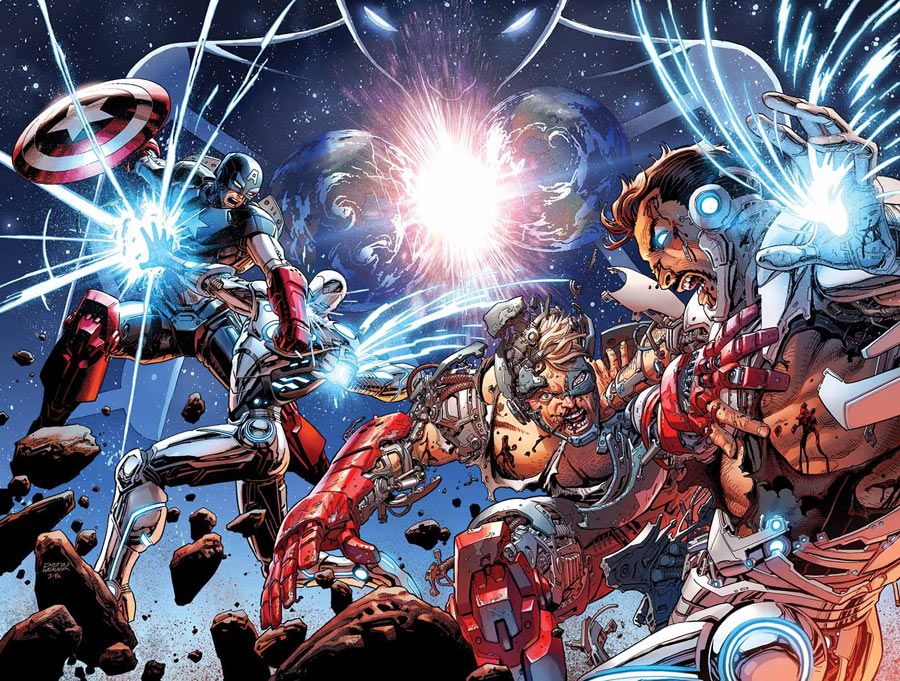After nearly 100 issues across several different titles, Jonathan Hickman's epic "Avengers" tale has reached its climax. This issue, the final of his run, leads readers into the epic "Secret Wars" event that will either change everything or nothing at all, depending on the promotional material one reads. Hickman's run has been about forcing heroes to make hard decisions in the face of insurmountable odds and this final story proves no different.
"Avengers" #44 has almost every element of Hickman's view of the franchise on display. There is the big action moment, with the Galactic Council preparing to eradicate the Earth; Hickman gives Tony Stark a final victory, one last hero moment before the impending doom of the universe. It's a great moment worthy of the Avengers, who are still flawed and reflective of the current predicament of the team. There is also the war of ideologies between Steve Rogers and Tony Stark, as Cap finally has it out with Iron Man, shield-to-face. What's surprising about this story arc is how steadfast Rogers has been in his belief that the greater picture should be ignored in favor of the personal betrayal he has felt. Cap is usually the big picture man; during "Infinity," he commanded most of known space in a galactic war against the Builders, but here a combination of betrayal and helplessness has rendered him near useless in the face of the impending collapse of the multiverse.
Steve, in modified War Machine armor, attacks like an animal, rending his friend apart, frothing at the mouth. This Captain America is angry, hurt, scared and doesn't know how to deal with those feelings. He needs to hear that Tony lied to him -- needs to hear his friend admit this -- at all costs. In his head, Tony's arrogance -- his hubris -- is what has put the universe in the dire place it now finds itself. In fact, Hickman uses the moment to reveal that the Avengers Machine was nothing more than a distraction until everyone else was in a place to listen to him about the end of the universe. Would there have been a better way to handle this? No one will ever know, as Hickman ends the book with the words that started both this and "New Avengers."
Artists Stefano Caselli and Kev Walker trade off pages throughout the issue. Caselli handles the quiet middle sequences of the book involving the Ultimate Universe and the Cabal's preparations for the final incursion. Though he doesn't have much more to draw than people standing and speaking to one another, his art still has power and fluidity. His Thanos commands attention in the room and on the page, a breathing totem of strength. Walker has the honor of illustrating the final blowout fight and revels in it, portraying the power of Steve's desperation and Tony's defensiveness in equally impressive measure.
With so many balls in the air, Hickman needs every page of this oversized issue to set up what happens next. Readers looking for a full resolution to the story will be disappointed to find that the issue ends as an ad for the "Secret Wars" miniseries, but most should have had that expectation going in to the issue. Though the full story Hickman has committed to has yet to see its final act play out, this issue feels like the climax to the themes he set forth to explore in this run. Looking back on the entire story as a whole, it's gobsmackingly impressive that as much of this 2-year story has held together as well as it did. Hickman has proven himself to be a Grant Morrisson-level plotter and may surpass the him if "Secret Wars" can stick the landing. At the very least, this story -- even without the line-wide publishing interruption that it will cause -- is the most ambitious piece of long form narrative storytelling Marvel has ever attempted. It's unknown what comes next for the franchise and who the writer will be, but whatever and whoever it is will have some very big and intimidating shoes to fill. Rabum Alal, Jonathan Hickman.

